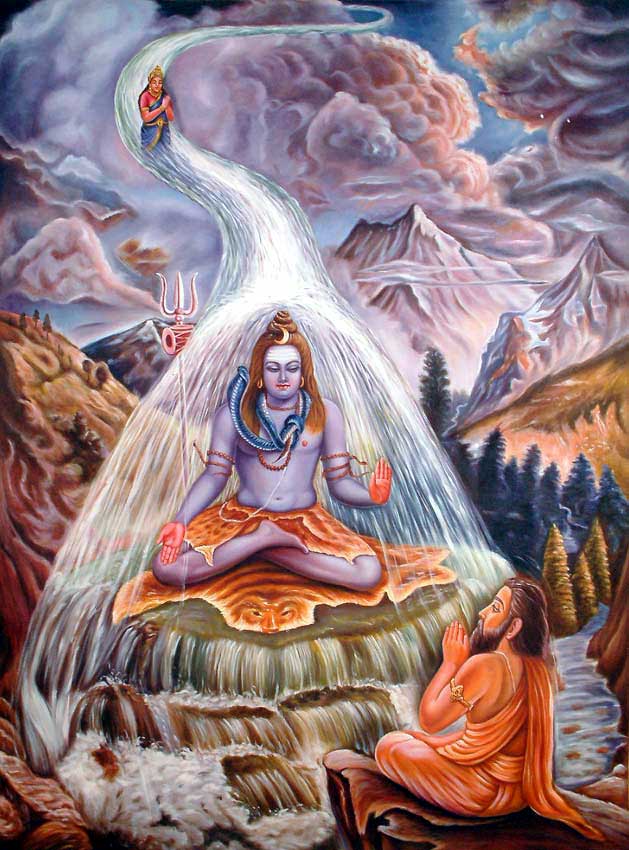|
According to Hindu mythology, King Bhageerath, son of King Dilip of Ikshvaku Dynasty, was the main architect in bringing Ganga (the holy river Ganges) down to earth. He was a virtuous man and he realized that a man should live to do good for others. As the legend goes, the ruler of Ayodhya, King Sagar, an ancestor of Rama, of the solar race, performed the Aswamedha sacrifice 99 times, where each time, the horse that he sent around the earth, returned to his Kingdom unchallenged. Indra, the God of Devas, in an act of jealousy, kidnapped and hid the horse in the hermitage of Kapila Muni-when the 100th sacrifice was being performed. The sixty thousand sons of King Sagar came to the hermitage of Kapila in their search for the horse and mistaking Kapila Muni to be the abductor, attacked him. An enraged Kapila Muni burnt the 60,000 princes to ashes. One of the grandchildren of King Sagar, hearing about the plight of his father and uncles, came in search of Kapila Muni and asked him for a solution to the problem, and was advised that the waters of the river Ganga would miraculously bring back the dead princes to life. The seventh generation of King Sagar, Bhageerath learnt about this unfulfilled wish of his father and grandfathers and vowed to bring Ganga down to earth to bring salvation to his grand fathers. Bhageerath then performed intense penance (Tapas) in favor of Lord Brahma. Brahma said, "O Bhageerath! I am pleased with your tapas. What is your wish?". Bhageerath was very happy to see Brahma. Bhageerath told Brahma "My forefathers in the nether world (patala lokam) lay dead burnt to ashes. The divine Ganga herself has to come to deliver them. So, please send the divine river and help me." Brahma replied, "I can gladly send Ganga. But the earth cannot bear her terrible force. So somebody will have to control her force. It can be done only by Lord Shiva, the Lord of all Worlds. Persuade Lord Shiva to arrest the force of Ganga and quieten her. Then I will send Ganga." Bhageerath began a severe tapas again for Lord Iswara. Finally Iswara was pleased and granted the wish of Bhageerath to control the turbulence of the descending Ganga. Lord Iswara stood on a big peak nearby, ready to receive the divine river. Ganga following the order of Lord Brahma decided to flow down to the earth. But she was proud of her force and decided to drag Lord Iswara along with the waters, so that the Gods in heaven would have some fun. Iswara felt the impact of the powerful flow. He knew that Ganga was haughty. So, he became wild with anger. As Ganga came down on him with a deafening roar, he tied her up amidst his flowing tresses so tightly that she couldn't slip away. Thus Ganga who came to drag him was imprisoned by him. Bhageerath saw this new difficulty that came up. He once again prayed to Lord Iswara to let Ganga flow to liberate his ancestors. Iswara said "I shall release Ganga in seven streams so that she cannot cause trouble again in her pride. One stream will follow you". Bhageerath patiently led the river down to the sea from the Himalayas. (http://www.sai-service.org/html/bvikas/STORIES/bhagiratha.html) (http://www.templenet.com/beliefs/gangadesc.htm) (http://www.rambhakt.com/ramayan/english/ramayan007.php) (http://www.iloveindia.com/spirituality/goddesses/ganga/legends.html )

On its way, Ganga flooded the Ashram of a Saint, Jahnu, who swallowed the river. Bhageerath prayed to the Saint for forgiveness and for the release of Ganga. The saint then let Ganga pass through his ears (Ganga is also called Jahnavi). The river flowed again. However, being unable to locate the exact spot where the ashes lay, Bhageerath requested Ganga to follow her own course. The Ganga, therefore, in the region of Bengal, divided herself into a hundred mouths and formed the Ganges delta. One of these streams washed the ashes, and offered salvation to the souls of the departed. The island with which this incident is associated is referred to as Sagar Island. Bhageerath's penance and the descent of the river Ganga are portrayed in stone at the Pallava heritage site at Mahabalipuram near Chennai. This story reveals Bhageerath's great devotion to duty. It shows how his strong determination which was not shaken by any kind of obstacle on the way helped him to achieve his goal. At IIT, Delhi, we have been developing a computational protocol for modeling and predicting protein tertiary structures at the atomic level. The software is named Bhageerath after the great Indian King who managed to accomplish the impossible task of getting the Ganges from heaven to earth.